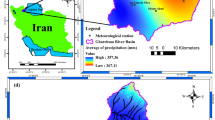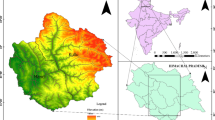Abstract
In this study, the zone-based hedging rule, which is the main operating policy adopted from multipurpose reservoirs in Korea is adjusted to reflect the multi-year droughts caused by climate change. Annual synthetic inflow series with different magnitudes of long memory were generated using the autoregressive fractional integrated moving average (ARFIMA) model. The generated inflow series were then disaggregated into 10-day series and utilized as input variables to derive the alternative hedging rules. The alternative hedging rules from this study were used in adaptive reservoir management by newly updated information. Finally, the performance of the suggested policy is measured in terms of frequency and magnitude under the historical inflow series. As a result, adaptive reservoir management demonstrated improvements in the following terms of the frequency of critical failures (water deficit ratio greater than 30%): 6.14% of the simulation period in the status quo (SQ) policy, and 2.99% in the adaptive management. However, the overall reliability of the reservoir during the simulation horizon was better when operated with the SQ policy (41.19%) than the results from adaptive management (26.42%). Because this result is in a good agreement with the original objective of the hedging rules, the adaptive policy suggested in this study holds promise and may be utilized in further reservoir management with an increase of potential drought risk from climate change.








Similar content being viewed by others
Availability of data and material
The datasets generated during and analyzed during the current study are available on Mendeley Data (https://data.mendeley.com/datasets/b54wd2gtdx/1).
Code availability
All codes that support the findings of this study are available on Github (https://github.com/gijoo-kim/watersupply_standard_update).
References
Bayazit M, Ünal N (1990) Effects of hedging on reservoir performance. Water Resour Res 26(4):713–719
Birhanu K, Alamirew T, Dinka MO, Ayalew S, Aklog D (2014) Optimizing reservoir operation policy using chance constraint nonlinear programming for Koga irrigation dam, Ethiopia. Water Resour Manag 28(14):4957–4970
Castelletti A, Pianosi F, Soncini-Sessa R (2008) Water reservoir control under economic, social and environmental constraints. Automatica 44(6):1595–1607
Cheng C-T, Wang W-C, Xu D-M, Chau KW (2008) Optimizing hydropower reservoir operation using hybrid genetic algorithm and chaos. Water Resour Manag 22(7):895–909
Eum H-I (2007) Non-flood period operational policies for the Geum River multireservoir system using sampling SDP with ESP. Ph.D. thesis, Seoul National University, Seoul, Republic of Korea
Eum H-I, Kim Y-O, Palmer RN (2011) Optimal drought management using sampling stochastic dynamic programming with a hedging rule. J Water Resour Plan Manag 137(1):113–122
Frederick KD, Major DC (1997) Climate change and water resources. Clim Change 37(1):7–23
Giuliani M, Herman JD, Castelletti A, Reed P (2014) Many-objective reservoir policy identification and refinement to reduce policy inertia and myopia in water management. Water Resour Res 50(4):3355–3377
Hashimoto T, Stedinger JR, Loucks DP (1982) Reliability, resiliency, and vulnerability criteria for water resource system performance evaluation. Water Resour Res 18(1):14–20
Herman JD, Quinn JD, Steinschneider S, Giuliani M, Fletcher S (2020) Climate adaptation as a control problem: Review and perspectives on dynamic water resources planning under uncertainty. Water Resour Res 56(2):e24389
Hosking JR (1984) Modeling persistence in hydrological time series using fractional differencing. Water Resour Res 20(12):1898–1908
Hurst HE (1951) Long-term storage capacity of reservoirs. T Am Soc Civ Eng 116(1):770–799
Kim GJ, Kim Y-O, Reed PM (2021) Improving the robustness of reservoir operations with stochastic dynamic programming. J Water Resour Plan Manag 147(7):04021030
Kim GJ, Kim Y-O (2021) How does the coupling of real-world policies with optimization models expand the practicality of solutions in reservoir operation problems? Water Resour Manag 35:3121–3137
Klemeš V (1977) Value of information in reservoir optimization. Water Resour Res 13(5):837–850
Koutsoyiannis D (2002) The Hurst phenomenon and fractional Gaussian noise made easy. Hydrol Sci J 47(4):573–595
Koutsoyiannis D (2003) Climate change, the Hurst phenomenon, and hydrological statistics. Hydrol Sci J 48(1):3–24
Koutsoyiannis D (2006) Nonstationarity versus scaling in hydrology. J Hydrol 324(1–4):239–254
Labadie JW (2004) Optimal operation of multireservoir systems: State-of-the-art review. J Water Resour Plan Manag 130(2):93–111
Loucks DP (2000) Sustainable water resources management. Water Int 25(1):3–10
Mohammad Ashrafi S (2021) Two-stage metaheuristic mixed integer nonlinear programming approach to extract optimum hedging rules for multireservoir systems. J Water Resour Plan Manag 147(10):04021070
Montanari A, Rosso R, Taqqu MS (1997) Fractionally differenced ARIMA models applied to hydrologic time series: Identification, estimation, and simulation. Water Resour Res 33(5):1035–1044
Milly PC, Betancourt J, Falkenmark M, Hirsch RM, Kundzewicz ZW, Lettenmaier DP, Stouffer RJ (2008) Stationarity is dead: Whither water management? Science 319(5863):573–574
Mudelsee M (2007) Long memory of rivers from spatial aggregation. Water Resour Res 43(1)
Neelakantan T, Pundarikanthan N (1999) Hedging rule optimisation for water supply reservoirs system. Water Resour Manag 13(6):409–426
Nowak K, Prairie J, Rajagopalan B, Lall U (2010) A nonparametric stochastic approach for multisite disaggregation of annual to daily streamflow. Water Resour Res 46(8):W08529
Pahl-Wostl C (2007) Transitions towards adaptive management of water facing climate and global change. Water Resour Manag 21(1):49–62
Pei W, Fu Q, Liu D, Li T, Cheng K, Cui S (2019) A novel method for agricultural drought risk assessment. Water Resour Manag 33(6):2033–2047
Quinn JD, Reed PM, Giuliani M, Castelletti A (2019) What is controlling our control rules? Opening the black box of multireservoir operating policies using time-varying sensitivity analysis. Water Resour Res 55(7):5962–5984
Salazar JZ, Reed PM, Herman JD, Giuliani M, Castelletti A (2016) A diagnostic assessment of evolutionary algorithms for multi-objective surface water reservoir control. Adv Water Resour 92:172–185
Seo SB, Kim Y-O, Kang S-U (2019) Time-varying discrete hedging rules for drought contingency plan considering long-range dependency in streamflow. Water Resour Manag 33(8):2791–2807
Shih J-S, ReVelle C (1994) Water-supply operations during drought: Continuous hedging rule. J Water Resour Plan Manag 120(5):613–629
Shih J-S, ReVelle C (1995) Water supply operations during drought: A discrete hedging rule. Eur J Oper Res 82(1):163–175
Sowers J, Vengosh A, Weinthal E (2011) Climate change, water resources, and the politics of adaptation in the Middle East and North Africa. Clim Change 104(3):599–627
Stedinger JR (1984) The performance of LDR models for preliminary design and reservoir operation. Water Resour Res 20(2):215–224
Stedinger JR, Sule BF, Loucks DP (1984) Stochastic dynamic programming models for reservoir operation optimization. Water Resour Res 20(11):1499–1505
Taghian M, Rosbjerg D, Haghighi A, Madsen H (2014) Optimization of conventional rule curves coupled with hedging rules for reservoir operation. J Water Resour Plan Manag 140(5):693–698
Tu M-Y, Hsu N-S, Tsai FT-C, Yeh WW-G (2008) Optimization of hedging rules for reservoir operations. J Water Resour Plan Manag 134(1):3–13
Yang G, Bowling LC (2014) Detection of changes in hydrologic system memory associated with urbanization in the Great Lakes region. Water Resour Res 50(5):3750–3763
Yeh WW-G (1985) Reservoir management and operations models: A state-of-the-art review. Water Resour Res 21(12):1797–1818
You JY, Cai X (2008a) Hedging rule for reservoir operations: 1. A Theoretical Analysis Water Resour Res 44(1):W01415
You JY, Cai X (2008b) Hedging rule for reservoir operations: 2. A Numerical Model Water Resour Res 44(1):W0141
Funding
This study received funding from K-water under "Study in the assessment of drought response capability and improvement plan of coordinated dams-weirs operation for river systems" and “Relief of water shortage in western Chungcheongnam-do by regenerating inflow and improving water supply adjustment standards.” The BK21 PLUS research program of the National Research Foundation of Korea also supported this work. The authors also wish to thank the Institute of Engineering Research, and Institute of Construction Environmental Engineering at Seoul National University and for providing research facilities for this work.
Author information
Authors and Affiliations
Contributions
Gi Joo Kim, Young-Oh Kim, and Seung Beom Seo contributed to the study conception and design. Material preparation, data collection and analysis were performed by Gi Joo Kim. The first draft of the manuscript was written by Gi Joo Kim. Young-Oh Kim and Seung Beom Seo commented on previous versions of the manuscript. Gi Joo Kim, Young-Oh Kim, and Seung Beom Seo read and approved the final manuscript.
Corresponding author
Ethics declarations
Ethics approval
Not applicable, because this article does not contain any studies with human or animal subjects.
Consent to participate
Not applicable, because this article does not contain any studies with human or animal subjects.
Competing interests
The authors have no conflicts of interest to declare that are relevant to the content of this article.
Additional information
Publisher's Note
Springer Nature remains neutral with regard to jurisdictional claims in published maps and institutional affiliations.
Rights and permissions
About this article
Cite this article
Kim, G.J., Seo, S.B. & Kim, YO. Adaptive Reservoir Management by Reforming the Zone-based Hedging Rules against Multi-year Droughts. Water Resour Manage 36, 3575–3590 (2022). https://doi.org/10.1007/s11269-022-03214-0
Received:
Accepted:
Published:
Issue Date:
DOI: https://doi.org/10.1007/s11269-022-03214-0




